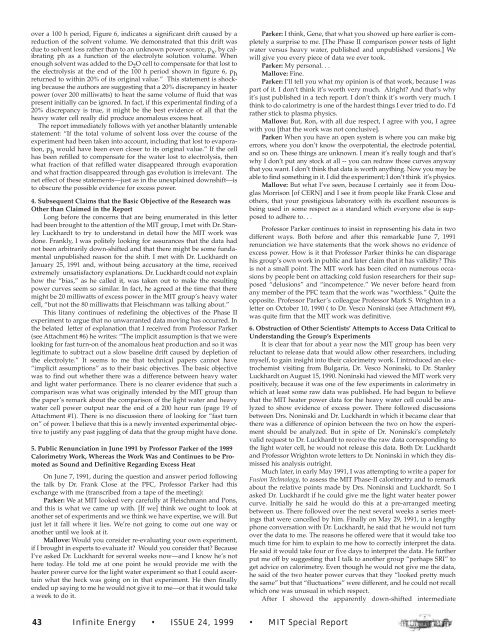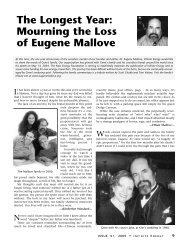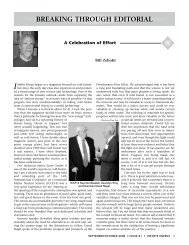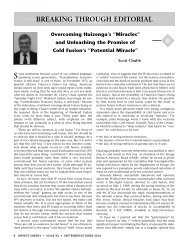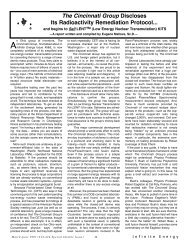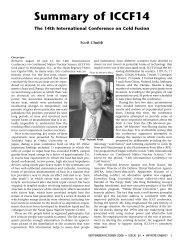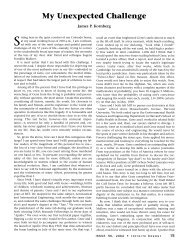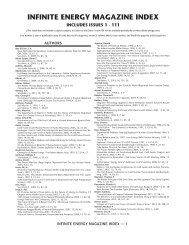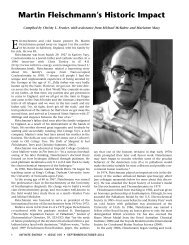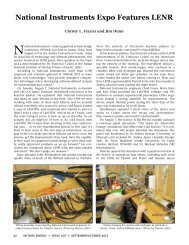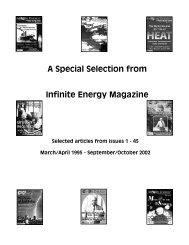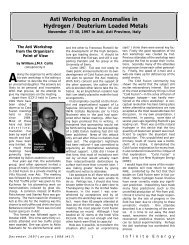MIT and Cold Fusion: A Special Report - Infinite Energy Magazine
MIT and Cold Fusion: A Special Report - Infinite Energy Magazine
MIT and Cold Fusion: A Special Report - Infinite Energy Magazine
Create successful ePaper yourself
Turn your PDF publications into a flip-book with our unique Google optimized e-Paper software.
over a 100 h period, Figure 6, indicates a significant drift caused by a<br />
reduction of the solvent volume. We demonstrated that this drift was<br />
due to solvent loss rather than to an unknown power source, p x , by calibrating<br />
ph as a function of the electrolyte solution volume. When<br />
enough solvent was added to the D 2 O cell to compensate for that lost to<br />
the electrolysis at the end of the 100 h period shown in figure 6, p h<br />
returned to within 20% of its original value.” This statement is shocking<br />
because the authors are suggesting that a 20% discrepancy in heater<br />
power (over 200 milliwatts) to heat the same volume of fluid that was<br />
present initially can be ignored. In fact, if this experimental finding of a<br />
20% discrepancy is true, it might be the best evidence of all that the<br />
heavy water cell really did produce anomalous excess heat.<br />
The report immediately follows with yet another blatantly untenable<br />
statement: “If the total volume of solvent loss over the course of the<br />
experiment had been taken into account, including that lost to evaporation,<br />
p h would have been even closer to its original value.” If the cell<br />
has been refilled to compensate for the water lost to electrolysis, then<br />
what fraction of that refilled water disappeared through evaporation<br />
<strong>and</strong> what fraction disappeared through gas evolution is irrelevant. The<br />
net effect of these statements—just as in the unexplained downshift—is<br />
to obscure the possible evidence for excess power.<br />
4. Subsequent Claims that the Basic Objective of the Research was<br />
Other than Claimed in the <strong>Report</strong><br />
Long before the concerns that are being enumerated in this letter<br />
had been brought to the attention of the <strong>MIT</strong> group, I met with Dr. Stanley<br />
Luckhardt to try to underst<strong>and</strong> in detail how the <strong>MIT</strong> work was<br />
done. Frankly, I was politely looking for assurances that the data had<br />
not been arbitrarily down-shifted <strong>and</strong> that there might be some fundamental<br />
unpublished reason for the shift. I met with Dr. Luckhardt on<br />
January 25, 1991 <strong>and</strong>, without being accusatory at the time, received<br />
extremely unsatisfactory explanations. Dr. Luckhardt could not explain<br />
how the “bias,” as he called it, was taken out to make the resulting<br />
power curves seem so similar. In fact, he agreed at the time that there<br />
might be 20 milliwatts of excess power in the <strong>MIT</strong> group’s heavy water<br />
cell, “but not the 80 milliwatts that Fleischmann was talking about.”<br />
This litany continues of redefining the objectives of the Phase II<br />
experiment to argue that no unwarranted data moving has occurred. In<br />
the belated letter of explanation that I received from Professor Parker<br />
(see Attachment #6) he writes: “The implicit assumption is that we were<br />
looking for fast turn-on of the anomalous heat production <strong>and</strong> so it was<br />
legitimate to subtract out a slow baseline drift caused by depletion of<br />
the electrolyte.” It seems to me that technical papers cannot have<br />
“implicit assumptions” as to their basic objectives. The basic objective<br />
was to find out whether there was a difference between heavy water<br />
<strong>and</strong> light water performance. There is no clearer evidence that such a<br />
comparison was what was originally intended by the <strong>MIT</strong> group than<br />
the paper’s remark about the comparison of the light water <strong>and</strong> heavy<br />
water cell power output near the end of a 200 hour run (page 19 of<br />
Attachment #1). There is no discussion there of looking for “fast turn<br />
on” of power. I believe that this is a newly invented experimental objective<br />
to justify any past juggling of data that the group might have done.<br />
5. Public Renunciation in June 1991 by Professor Parker of the 1989<br />
Calorimetry Work, Whereas the Work Was <strong>and</strong> Continues to be Promoted<br />
as Sound <strong>and</strong> Definitive Regarding Excess Heat<br />
On June 7, 1991, during the question <strong>and</strong> answer period following<br />
the talk by Dr. Frank Close at the PFC, Professor Parker had this<br />
exchange with me (transcribed from a tape of the meeting):<br />
Parker: We at <strong>MIT</strong> looked very carefully at Fleischmann <strong>and</strong> Pons,<br />
<strong>and</strong> this is what we came up with. [If we] think we ought to look at<br />
another set of experiments <strong>and</strong> we think we have expertise, we will. But<br />
just let it fall where it lies. We’re not going to come out one way or<br />
another until we look at it.<br />
Mallove: Would you consider re-evaluating your own experiment,<br />
if I brought in experts to evaluate it? Would you consider that? Because<br />
I’ve asked Dr. Luckhardt for several weeks now—<strong>and</strong> I know he’s not<br />
here today. He told me at one point he would provide me with the<br />
heater power curve for the light water experiment so that I could ascertain<br />
what the heck was going on in that experiment. He then finally<br />
ended up saying to me he would not give it to me—or that it would take<br />
a week to do it.<br />
Parker: I think, Gene, that what you showed up here earlier is completely<br />
a surprise to me. [The Phase II comparison power tests of light<br />
water versus heavy water, published <strong>and</strong> unpublished versions.] We<br />
will give you every piece of data we ever took.<br />
Parker: My personal. . .<br />
Mallove: Fine.<br />
Parker: I’ll tell you what my opinion is of that work, because I was<br />
part of it. I don’t think it’s worth very much. Alright? And that’s why<br />
it’s just published in a tech report. I don’t think it’s worth very much. I<br />
think to do calorimetry is one of the hardest things I ever tried to do. I’d<br />
rather stick to plasma physics.<br />
Mallove: But, Ron, with all due respect, I agree with you, I agree<br />
with you [that the work was not conclusive].<br />
Parker: When you have an open system is where you can make big<br />
errors, where you don’t know the overpotential, the electrode potential,<br />
<strong>and</strong> so on. These things are unknown. I mean it’s really tough <strong>and</strong> that’s<br />
why I don’t put any stock at all -- you can redraw those curves anyway<br />
that you want. I don’t think that data is worth anything. Now you may be<br />
able to find something in it. I did the experiment; I don’t think it’s physics.<br />
Mallove: But what I’ve seen, because I certainly see it from Douglas<br />
Morrison [of CERN] <strong>and</strong> I see it from people like Frank Close <strong>and</strong><br />
others, that your prestigious laboratory with its excellent resources is<br />
being used in some respect as a st<strong>and</strong>ard which everyone else is supposed<br />
to adhere to. . .<br />
Professor Parker continues to insist in representing his data in two<br />
different ways. Both before <strong>and</strong> after this remarkable June 7, 1991<br />
renunciation we have statements that the work shows no evidence of<br />
excess power. How is it that Professor Parker thinks he can disparage<br />
his group’s own work in public <strong>and</strong> later claim that it has validity? This<br />
is not a small point. The <strong>MIT</strong> work has been cited on numerous occasions<br />
by people bent on attacking cold fusion researchers for their supposed<br />
“delusions” <strong>and</strong> “incompetence.” We never before heard from<br />
any member of the PFC team that the work was “worthless.” Quite the<br />
opposite. Professor Parker’s colleague Professor Mark S. Wrighton in a<br />
letter on October 10, 1990 ( to Dr. Vesco Noninski (see Attachment #9),<br />
was quite firm that the <strong>MIT</strong> work was definitive.<br />
6. Obstruction of Other Scientists’ Attempts to Access Data Critical to<br />
Underst<strong>and</strong>ing the Group’s Experiments<br />
It is clear that for about a year now the <strong>MIT</strong> group has been very<br />
reluctant to release data that would allow other researchers, including<br />
myself, to gain insight into their calorimetry work. I introduced an electrochemist<br />
visiting from Bulgaria, Dr. Vesco Noninski, to Dr. Stanley<br />
Luckhardt on August 15, 1990. Noninski had viewed the <strong>MIT</strong> work very<br />
positively, because it was one of the few experiments in calorimetry in<br />
which at least some raw data was published. He had begun to believe<br />
that the <strong>MIT</strong> heater power data for the heavy water cell could be analyzed<br />
to show evidence of excess power. There followed discussions<br />
between Drs. Noninski <strong>and</strong> Dr. Luckhardt in which it became clear that<br />
there was a difference of opinion between the two on how the experiment<br />
should be analyzed. But in spite of Dr. Noninski’s completely<br />
valid request to Dr. Luckhardt to receive the raw data corresponding to<br />
the light water cell, he would not release this data. Both Dr. Luckhardt<br />
<strong>and</strong> Professor Wrighton wrote letters to Dr. Noninski in which they dismissed<br />
his analysis outright.<br />
Much later, in early May 1991, I was attempting to write a paper for<br />
<strong>Fusion</strong> Technology, to assess the <strong>MIT</strong> Phase-II calorimetry <strong>and</strong> to remark<br />
about the relative points made by Drs. Noninski <strong>and</strong> Luckhardt. So I<br />
asked Dr. Luckhardt if he could give me the light water heater power<br />
curve. Initially he said he would do this at a pre-arranged meeting<br />
between us. There followed over the next several weeks a series meetings<br />
that were cancelled by him. Finally on May 29, 1991, in a lengthy<br />
phone conversation with Dr. Luckhardt, he said that he would not turn<br />
over the data to me. The reasons he offered were that it would take too<br />
much time for him to explain to me how to correctly interpret the data.<br />
He said it would take four or five days to interpret the data. He further<br />
put me off by suggesting that I talk to another group “perhaps SRI” to<br />
get advice on calorimetry. Even though he would not give me the data,<br />
he said of the two heater power curves that they “looked pretty much<br />
the same” but that “fluctuations” were different, <strong>and</strong> he could not recall<br />
which one was unusual in which respect.<br />
After I showed the apparently down-shifted intermediate<br />
43 <strong>Infinite</strong> <strong>Energy</strong> • ISSUE 24, 1999 • <strong>MIT</strong> <strong>Special</strong> <strong>Report</strong>


